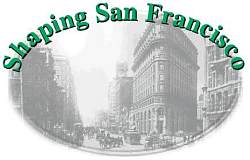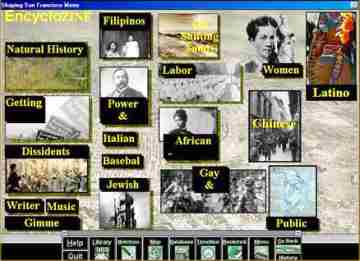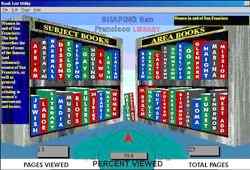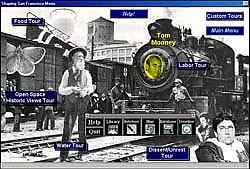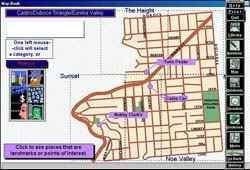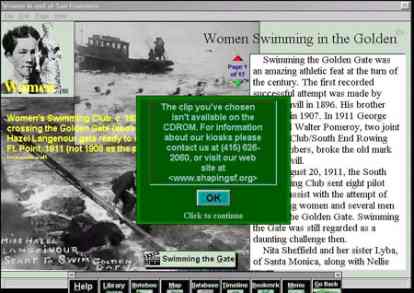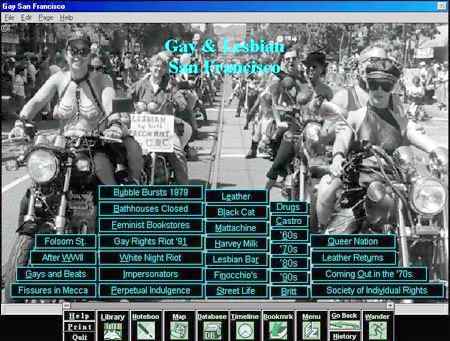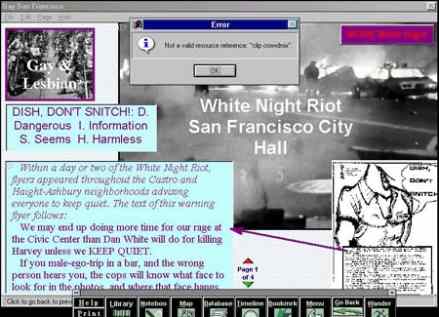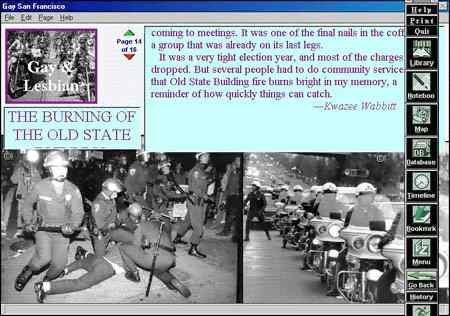Shaping San Francisco: An Interactive Multimedia Excavation of the Lost History of San Francisco. Chris Carlsson, Greg Williamson, and Jim Swanson. San Francisco: Cloverleaf Multimedia Productions, 1998. CD-ROM: PC, Windows 3.x, Windows 95 and Windows NT. More information is available at the Shaping San Francisco Web site: http://www.shapingsf.org. Introduction
"The contents are arranged by subject and neighborhood," write the authors, "Shaping San Francisco offers ways to dig beneath the surface and discover unexpected connections that link across subjects, areas, and times." The project's newsletter and web site make it clear that this is a populist project, aimed as much toward providing public access kiosks (they have kiosks running at the new San Francisco Main Library, at Modern Times bookstore, and at City Lights bookstore), as it is at the distribution of this CD-ROM product. Introductory notes warn against "the absurd notion that digital media can supercede the book," and true to this sentiment, City Lights has published a "companion volume" of essays called Reclaiming San Francisco: History, Politics, and Culture, edited by James Brook, Chris Carlsson, and Nancy J. Peters. We reviewed the pre-release version 1.5, with the understanding that some features were not yet fully functional, such as the database look-up. Anyone familiar with San Francisco has already recognized that this is a quintessential left-progressive San Francisco production. City Lights is the landmark home of the Beats, owned by San Francisco's current Poet Laureate Lawrence Ferlingetti. Shaping San Francisco is somewhat in the tradition of the American Social History Project founded by Herbert Gutman (see the review in the last issue of this journal of Who Built America?) or Howard Zinn's A People's History of the United States. But it is also far less deliberately socialist than those works. The users will find strong representation of all the principal groups who have "reclaimed" San Francisco since the Movement of the 1960s, but also they will find much mainstream history of Spanish Missions, urban development stories, and baseball. The authors/editors/organizers clearly invite contributions (although they do not specify how volunteers are to contribute in a regular, ongoing way) to future editions. "We make no claims to having the last word on local history; in fact, we argue that there can no more be a last word on history than there can be an end to history!" In light of this brief introduction, it should be clear that Shaping San Francisco is caught in a very interesting contradiction: it is both for and against the digital medium. This contradiction is linked to the authors/editors/organizers' antipathy to professional history and hope for creating a forum for the everyday voices supposedly shut out by academic scholars. Thus, we think this is a very important test case for the possibilities and limitations of multimedia history, and our review will address the linked issues of form, content, and the creative process. After a brief descriptive overview, we will turn to a careful critique that examines this work in the light of its own populist goals. An Overview
This is no small feat, since San Francisco is a major city with a complex past and present. In several sessions ranging from 30 minutes to 2 hours, we (separately and together) managed to visit and read nearly all of the screens. These range from short biographical sketches of scores of historical figures—many of them not typical City Father types—to very useful overviews of major historical events. These events range from the 1934 General Strike led by Harry Bridges and the long shore workers, to the white Night Riot of 1979, protesting the manslaughter verdict of Dan White, confessed killer of Mayor George Moscone and gay Supervisor Harvey Milk. Readers can access these materials via several search metaphors: the Encyclozine, which organize the screens according to their main topic, a "Library" in which each subject or locale is represented as the spine of a book; a
There does not exist, at present, a single "book" on San Francisco that offers such a wide range of subject matter within such a long time range of coverage (Shaping San Francisco is even strong on representation of the pre-European contact human and natural history). But, each of the subject areas is definitely covered much more fully in books that are easily accessible in libraries or bookstores. Again, the authors/editors/organizers are forthright about this limitation: they call it only "a good starting point" for research "best used in conjunction with a well-stocked library of books and periodicals." Still, most of what one encounters in Shaping San Francisco could probably be compiled into a low-tech "book," replete with lots of photos and graphics, to serve in the same way as a "good starting point" for a deeper exploration of San Francisco. What Shaping San Francisco does offer, which is currently not possible with such printed books, is a rather limited selection of audio and video clips. Watching a participant in the 1934 Bloody Thursday police attack on the waterfront workers describe the experience of a bullet whizzing by his head (which apparently struck someone behind him, he notes), is a powerful encounter with history. Thus, at bottom, Shaping San Francisco offers just what it promises in its modest self-promotion: a lively introduction to a great and complex city. But now we must ask, why attempt these goals in a CD-ROM format? Especially if the explicit goal of the project is to create a public sphere which could "compensate" the groups who had been overlooked or denied access to the process of writing traditional history: "the racial minorities, workers, the impoverished underclass, women." How much more is added to the powerful democratic medium of the book (or to the mass influence potential of a documentary film) by creating a populist product which is nevertheless restricted to an expensive individualized-consumption medium containing a few video clips and a few hyperlinks? What ends are served by creating this "interactive" work? Are the costs of the technological requirements of the CD-ROM format and the difficulty of public access really justified by some educational or "first voice" empowering goal, unreachable by print medium, or perhaps by print plus documentary film and video? When evaluating the cost-effectiveness of "new media," we must consider both the production and the exhibition costs. CD-ROMs usually cost less to produce than major documentary films, but documentary films reach many more people because they are relatively cheap to exhibit. Thus, we must ask whether the decreased cost and difficulty of producing CD-ROM products leads in the end to an increased cost and difficulty of distributing and exhibiting them. Is the choice of this CD-ROM medium, then, a hurdle rather than an enhancement of the explicit populist goal? Exploring this paradox, we were reminded of the century-old difference between Lumiere's public projection device and the peep-hole machines of Thomas Edison in light of the significance cinema and home video have already gained in the realm of class struggle, politics of empowerment, and cultural independence. It is very hard to imagine the radical manifestoes of "third cinema," the metaphors of the camera as a gun, or even the empowering first-person documentaries, videos, and oral histories which this century has witnessed, in an exhibition practice of a middle-class home PC or a single-user "public" kiosk, much like Edison's kinetoscope. Structural Critique: The Tyranny of the Screen Too little is gained by simply converting a book into digital form to justify the great cost of doing it well and the even greater cost of reaching the public, and to justify the serious class barriers to access raised by these media. Even public kiosks require a large sum of money in hardware, which in turn demands at least one hour per week of maintenance (this is not to even consider the labor costs of upgrading the software product itself). This sum and the minimum 52 hours of skilled labor could put an empowering book, video, slide show, and guest speaker in hundreds of classrooms and auditoria, or on a public television talk show with thousands of viewers? Clearly, by this measure, history with populist goals on a CD-ROM needs to achieve something which is practically impossible via the traditional media or, which engages the public in a radical, active participation, in order to justify both its opportunity costs and to fulfill its populist goals. So, to sum our line of questioning so far: a populist CD-ROM will need to have qualitative advantages over books and documentary films because it is inherently inferior to those media by quantitative measures. What could a CD-ROM do which a book or slide show, lecture tour, or documentary film could not do? First, it could provide on a very compact, portable medium vast quantities of images or texts or data. Second, it could offer a relational structural matrix for linking and exploring even a more modest amount of information, which in itself is fundamentally unlike the experience of reading a book. Similarly, it can engage the viewer in an active mode of "reading" and structuring the elements of the text, unlike the passive and didactic models of spectatorship of classical cinema, turn-of-the century travelogues, or panoramic railroad "tours." This second goal, usually called "interactivity," has been vastly overrated as a distinction of the digital media. Footnotes, indexes and catalogs for example, are very old and very powerful examples of "hyperlinks," "hot links," and random-access "databases." Gordon Wood noted long ago that the pamphleteers of the American Revolution actually wrote footnotes to their footnotes (links to links). Likewise, the "nonlinear" character of multimedia has long been a feature of the newspaper or a cross-referenced book, through which readers skim, browse, read out of order, and create their own personal links. It takes some effort, then, to imagine a CD-ROM which actually adds to the structural potentials of traditional media. One thing a book typically does not do, for example, is present different text each time you open a given page, or give you a complex branching network of narratives that may vary over multiple readings.
Each screen typically has one big graphic element, a narrow text box with a scrolling column of text (and a maddeningly small pair of scroll buttons), and perhaps a few extra thumbnails or links.
The reader may go "Back" to the top level of "Gay/Lesbian," or "Wander," which always takes you though all of the screens in this thematic cluster or the chosen tour, in the same order. Unfortunately, the tyranny of "the screen" in Shaping San Francisco extends beyond the technical limitations of the authoring tool and its rather annoying layout rigidities. It becomes a serious epistemological threat to the whole project and its intent to provide interaction "between people," supply a "living history" of the city, or empower its users and the underprivileged social groups. A great deal of the problems in Shaping San Francisco are related to a profound misunderstanding of the concept of "interactivity" and its true potentials and to the inherent lack of freedom of the user to recombine the various elements of knowledge, supplied on the disk: clips, excerpts, documents, and narratives. In the roll-out speech on January 22, 1998, published on the web site, Chris Carlsson ambitiously declared the difference between this interactive product and other multimedia texts: Shaping San Francisco is different than previous efforts in multimedia in a number of ways. First it is designed to promote interactivity between humans rather than between a person and a box. Much of the hype around this new media form focuses on the buzzword 'interactivity.' Interactive multimedia is really an elaborate, technologically sophisticated form of multiple choice, nothing more. Shaping San Francisco is a bunch of linked computer files that are designed to reinforce creative responses to our daily lives today. (Introducing Shaping San Francisco, Chris Carlsson's rollout speech on Jan. 22, 1998, published on the Shaping San Francisco web site: http://www.shapingsf.org.) Ironically, Carlsson grossly underestimates the actual possibilities of digital interactivity. Pre-set multiple-choice links do indeed falsely masquerade as "interactivity," but an intelligent relational database can link and recombine various records and record-sets in an infinite way, giving the user a real "participatory freedom"of research and exploration. It is possible that the makers of Shaping San Francisco, not understanding this, mistakenly felt themselves limited to the faux representation of interactivity (being simply a technology of "multiple choice" out of "a bunch of linked computer files"). For whatever reason, Shaping San Francisco reproduces the undemocratic (forced-choice) structure that Carlsson rightly criticized in his roll-out speech. The makers' misunderstanding, then, may have led to the unfortunate choices of making the smallest structurally indivisible unit the "screen" or "the page." "The screen," pre-designed and pre-linked by the authors to a few other screens is not and should not be the structural unit of knowledge in a public historical endeavor such as Shaping San Francisco. In fact, it limits interaction precisely to an interaction to one "between a person and a box." Think now of the very basic examples the "interactivity" of a telephone or of the game of tic-tac-toe, versus the interactivity of a pre-programmed ATM machine. When it comes to chess, most of us prefer to play the game by the infinite possible variations in moves, rather than to be led through a very limited number of screens with game positions which the authors had once played and which are arranged in thematic "sections" or "tours," marked in the upper-left corner of the board. Shaping San Francisco provides only one visual and thematic context for each of its documents, narratives and other blocks of knowledge, included on the CD. This may be why the library and the database are the weakest tools for exploring the contents of the CD-ROM. They seem like artificial add-ons to the "bunch of linked computer files" (indeed, the database is a still-unfinished feature) rather than parts of a carefully planned and expandable data structure. Furthermore, the authors claim that: Shaping San Francisco is designed to create a new kind of public space around our shared histories. It is not the last word on local history, but the first edition of a media experiment in which we can tell each other how things were, what shaped our lives, what was tried and what worked and what didn't? Ideally, Shaping San Francisco will grow and publish future editions. If Shaping San Francisco is widely used it can reach its goal of becoming a living archive of San Francisco. [http://www.shapingsf.org/rollout.htmlweb site.] It is not clear, however, how at present, Shaping San Francisco can transcend the limits of a singular effort of a limited number of authors trying to reach an audience of consumers and users with several uniformly styled slide-shows on a disk. The bridge between "participatory" history and "authored" history cannot be crossed if we only predict what could happen with future editions or because we put the "history" on a CD-ROM, rather than a book. Even if we build the biggest number (or "community") of pre-programmed ATM machines, each only giving us the freedom to choose between "withdrawal" and "deposit" screens, we would not become "interactive" participants in a financial community nor would we be empowered to become bankers. We are far from maintaining that "the medium" here is the whole "message." Ironically, however, both the medium and the central design metaphors are shaping Shaping San Francisco into a ready-made "edutainment" audio-visual product of its own, which functions in a direction contrary to the project's central purpose. The authors themselves often feel the need to justify their fixed design paradigm and alleviate this contradiction. One of these approaches is, of course, to stress the "extra-textual" efforts to set-up the public practice of exhibition of this product (kiosks, library tours, a web-site version, which could create and links to "real" communities and discussion forums). However, as we have said, these efforts are epistemologically quite contrary to the self-contained pre-packaged CD-ROM commodity they are actually marketing. This CD-ROM relies on the classic didactic relationship between a text and its viewers, where we are led through the content by the authors, much like in an old-fashioned "voice-of-God" or "talking head" documentary or an illustrated textbook narrative. Content Critique: We now turn to a most unnecessary limitation of this very well-intentioned work. The authors make a principal theme statement at the outset, that this interactive history is built not only from professional histories, but also from "a wide range of writings that are based on journalistic sources, anecdotes, and oral histories." Their complete statement of purpose and underlying epistemological orientation needs to be quoted at length, because it goes to the very heart of the project: "The field of history, especially as taught in the universities of the United States, is a highly specialized field with a range of rules and expectations to help assure that what earns the name history has passed certain standards of truth and objectivity. This can be helpful, but it can also be terribly narrow. In response to the inadequacy of this self-regulating system, many new historians of the past few decades have sought to legitimize other sources and other voices as plausible evidence for understanding the past. Racial minorities, workers, the impoverished underclass, women, all have been overlooked in traditional histories, largely because the rules of history required that there be documentation as proof. But that is a highly class-biased and self-selective system of rules of evidence, which automatically excludes that large majority of the world's population who didn't—or weren't able to—record their histories in the past." We find this claim to be deeply erroneous and worse: it is saturated with the worst assumptions from a democratic and socialist point of view. The assumption behind this is that mainstream academic scholarship is necessarily bourgeois, and that its "rules" are part of a system of class privilege which withhold from the masses their history through an artificial criterion of demanding "documentation as proof." For starters, one wonders where the authors of this project have been for the last century, as the scholarly work of major leftist scholars including W.E.B. DuBois, Raymond Williams, Herbert Gutman, Philip S. Foner, Eric Foner, Eugene Genovese, Linda Gordon, Dolores Hayden, and many others, have carefully recovered the voices of "racial minorities, workers, the impoverished underclass, women," using precisely those rules of documentation so disparaged by this project. We would hasten to remind the authors of Shaping San Francisco that Karl Marx considered himself a scientist (he sent his works to Charles Darwin hoping to win his approval, but since Darwin's German was inadequate, he never heard back). V.I. Lenin held that revolution could only succeed if the masses were armed with the best scientific scholarship. The only defensible socialist position on the access to revolutionary social knowledge, we contend, is one which empowers the masses with the tools of scientific knowledge. What we mean by "scientific" (a term much abused by postmodernists) is very simple: a falsifiable claim. What good would it do the proletariat or gay/lesbian subcommunities if historians or nonhistorians made up unprovable stories about their condition? How could we possibly go about understanding the functionings of advanced patriarchal straight and white capitalist society, if we accepted any claim without worrying first of all whether anyone would be able to verify (that is, falsify) it? How, after all, do we attack the injustices of racism and capitalism? One falsifies the claims of spokespersons of the dominant class or race who assert that these systems are fair and egalitarian! Do the authors really accept the implications of their own statements, that truth is not a concern to the exploited and the oppressed? Let us take just a few examples to illustrate why this attitude will not serve the public in the long run, and why it is wholly uncalled for. The screen about the White Night Riot 21 May 1979 has a very interesting text from a flier that was pasted up in the days after the riot.
Another example is the interesting eyewitness account of the "Burning of the Old State Building in 1991."
Conclusion Shaping San Francisco is a valuable experiment with a highly laudible purpose. We think it will be useful within its own limitations, and we even recommend it for anyone who would like an informative overview of San Francisco not currently available in printed book form. But we hope also that the authors/editors/organizers will in future versions think seriously about how to close the very wide gap between the medium and their own goals. We hope that other projects, not yet started, will also take these concerns very seriously. At the same time, we may be facing the absolute limits of a medium that is trapped within a very expensive capitalist consumer market. Some similar efforts with similar goals, such as the Who Built America? CD-ROM of the American Social History Project, have achieved more but have also cost more. The medium chosen by the makers of Shaping San Francisco must itself struggle to rise above an already notoriously low standard of quality. The digital media are dominated by their manufacturers and corporate sponsors. CD-ROMs are not the information equivalent of homemade Viet Cong land mines. They can only be produced using hardware and software that needs to be purchased from vendors who currently trade their stocks in the billions of dollars. The vast majority of information content available via digital means is packaged by for-profit distributors who care little about falsifiable documentation, and care almost not at all about the empowerment of the dispossessed. Anyone from that corporate world of commercial infotainment can hire superb designers and engineers to make attractive interactive products. But precious few have attempted to use those same media for the goals stated by these authors. We applaud the attempt in Shaping San Francisco, but also hope to see a better realization.
Philip J. Ethington ~ End ~ CD-ROM Review of Shaping
San Francisco
Comments | JMMH Contents |
